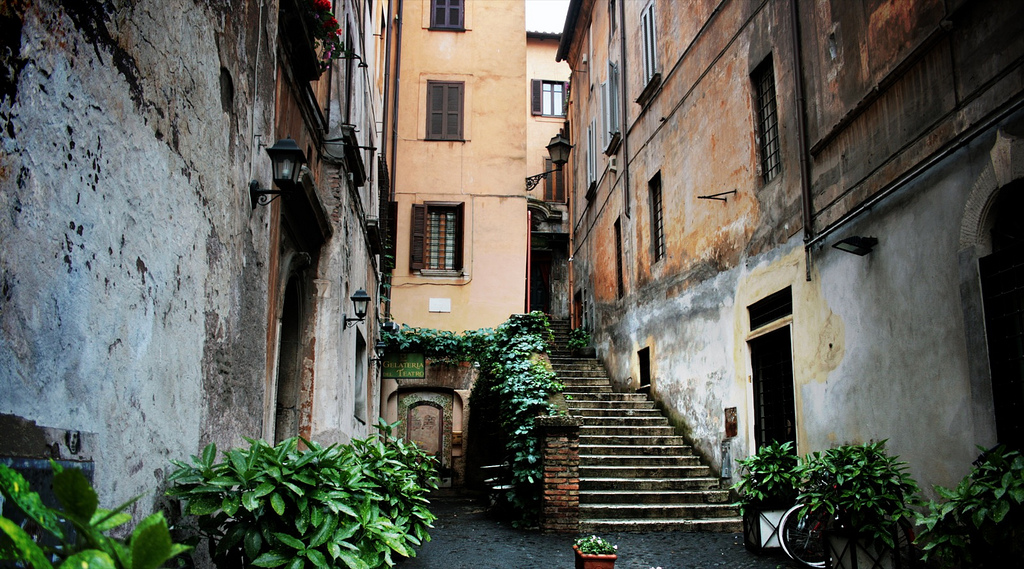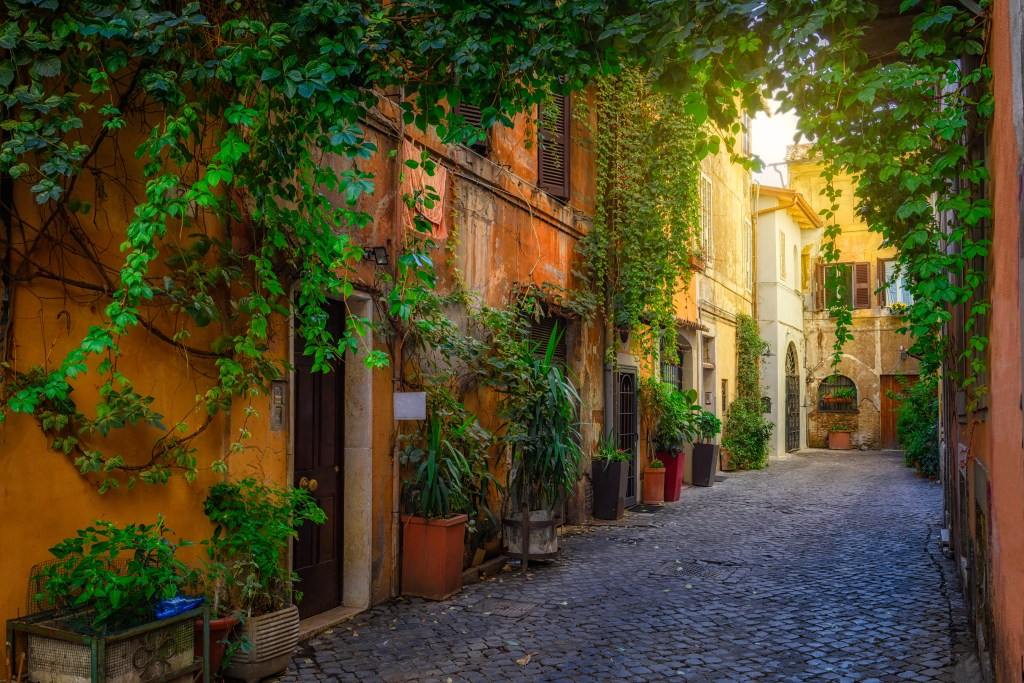Where to Live in Rome
Rome is an expensive place to live. It’s still not quite at the level of London, or even Paris, but it’s close. Citywide, the average rent for 100 square meters, which would be a large two-bedroom apartment, is about €1,600. In the center of town, that’s closer to the rate for a nice one-bedroom apartment. Suffice it to say that if you’re looking for a one-bedroom apartment in a somewhat desirable part of the capital, you should budget a minimum of €1,300.

Prices vary widely depending on standard measurements such as location, size, and amenities, but also on more Rome-specific considerations, such as the presence of an ancient column or some other artistic treasure buried in the walls. The greatest factor, of course, is location. Rent for apartments inside the city’s Aurelian walls is almost always more expensive than for those outside them. The following descriptions of neighborhoods give an indication of what you might expect to pay in rent per square meter, the measurement used in all classified ads. For a single-bedroom apartment, multiply by 50 or 60 square meters. For a two-bedroom place, multiply by 70 or 80.
For buyers, prices will vary even more widely than rents. As a rough indication, the average home downtown sells for €10,000 per square meter. Add on the 3 percent tax for first-time property owners (or 7 percent for those who already own), and the average two-bedroom apartment downtown will cost about a million dollars.
That’s for the choicest area of Rome. Farther out from the center, prices drop dramatically. Parioli, for example, costs about two-thirds of that, while suburban real estate averages about €2,500 per square meter.
Where to Live in Rome
Living in Downtown Rome
The first on any list of Roman neighborhoods is the centro storico (downtown), which in Rome’s case means the part that holds the major monuments and squares. This vaguely defined “historic center” is bound on the western side by a sharp curve in the Tiber, and more or less contained on the eastern side by the Colosseum, Santa Maria Maggiore, the Baths of Diocletian, and the city’s ornate park, the Villa Borghese. If you had an apartment here, you could walk to a dozen of the Western world’s most photographed monuments in just a few minutes, plus most of the government buildings. The prices reflect this. If a map of downtown Rome were a Monopoly board, the Spanish Steps would be Boardwalk and the Via Veneto would be Park Place. Rents there are highest, at about €25 or €30 per square meter. Apartments near the Pantheon, Piazza Navona, and Piazza del Popolo will come close to that price, as will any address directly across the river in the rioni of Borgo and Castel Sant’Angelo. There, you can wake up in the morning and walk over the Tiber on your way to work as flocks of pigeons flap into the hazy pink sunrise.

The southeastern limits of the downtown are marked by the rione of Monti, a cozy corner of alleyways between the Termini train station and the Colosseum. It is an excellent choice if you have the means. In my opinion Monti has a more neighborly feel than some of the posher districts described above, but because it has become extremely popular with the expatriate crowd, especially, prices have crested to €25 per square meter. Sadly, whether due to the remarkable write-ups for local restaurants, or its setting for the Woody Allen film To Rome With Love, it’s become absorbed into routine tourist routes, prompting the mayor to push for pedestrian-only status for Monti’s alleyways.
On either side of the Vatican are two of the more comfortable, upper-middle-class quarters of Rome, called Prati and Trastevere. They each attract slightly different crowds. Trastevere is a dream for students, artists, and other bookstore-browsing types who have a bit of extra cash to spend on an apartment with character. It may be a stretch to call it Rome’s answer to Greenwich Village, but there are some good hole-in-the-wall bars and restaurants with a rustic flavor. There is even a small English-language movie theater, the Pasquino. If you’re single and in your 20s or 30s, or even middle-aged with an appreciation for hip venues, this would be an ideal place to live. Rent here has also risen to €25 per square meter in many cases. Prati is more staid and quiet, the home of the national broadcaster RAI and a number of law offices, and is generally a serene place to raise a family. There are some very good restaurants in the area and a few decent shops, but mostly it is a modern residential zone with wide, relatively uninteresting boulevards. It is just slightly cheaper than spicier Trastevere.

Across the river from Prati is a similarly conservative, family-oriented neighborhood that’s even better-known for its yuppies. Parioli is so stately, in fact, that many national governments have set up their embassies here. Cafés and shops play to the whims of cautious diplomats looking to make a good impression. If you see a group of young men with neatly ironed slacks driving expensive mopeds, you may safely assume that they are pariolini. All snickering aside, Parioli is a very clean neighborhood with some elegant apartments, and if that’s your cup of espresso, it’s well worth the price: about €23 per square meter.
Living Outside the Center of Rome
The centro storico, Monti, Borgo, Prati, Parioli, and Trastevere are about as good as it gets, geographically. If you can’t walk to where you are going, it’s only a short moped or bus ride away. But as real estate prices in Rome move out of reach even for moneyed foreigners, you will probably want to look a little farther afield for the bargains, and Rome has a number of well-connected neighborhoods outside downtown.
Monteverde has long been a popular option for expats looking for a more affordable apartment. Although it is tucked back on Janiculum Hill behind Trastevere, it might as well be downtown if you consider the convenient public transportation along Viale Trastevere. Modern, air-conditioned trams run from the heart of Monteverde to Largo Argentina, just steps from the Pantheon, in about 15 or 20 minutes. Monteverde Vecchio, as the name might suggest, has older and more interesting architecture than its younger sibling, Monteverde Nuovo, and is therefore a tad more expensive. With the exception of the district’s more luxurious buildings, both are still cheaper than downtown. You can find an apartment in Monteverde Vecchio for as little as €15 per square meter, and even slightly less in Monteverde Nuovo.
Newsletter Signup
By clicking ‘Sign Up,’ I acknowledge that I have read and agree to Hachette Book Group’s Privacy Policy and Terms of Use
A similarly priced neighborhood can be found on the opposite side of Janiculum Hill from Monteverde, directly behind the Vatican. It takes its name from the avenue that runs through it, Gregorio VII, but it’s also known as Pio XI after the square where the street terminates. (Streets and squares around here are often named for popes.) This is a modern and comfortable neighborhood, but relatively short on charm.
Another middle-of-the-road option is Testaccio, just south and across the river from Trastevere. The general area is also known as Ostiense. This is the old butchers’ district, which today holds meat markets of a different kind: discos and singles bars. There are also some excellent restaurants in the area, serving true Roman specialties. Plan on about €17 per square meter.
Farther south down Via Ostiense, you’ll reach EUR, Mussolini’s ambitious, sprawling exposition center. The architecture is Fascist, naturally, and the apartments surrounding it house mostly middle-class couples and families. For the same €1,500 that you could spend for a one-bedroom apartment downtown, you could find a three-bedroom, two-bath apartment, maybe even with a garage, in EUR. The price is right, but the commute can be tedious.
Closer to the center are a few other affordable areas. Two behind the Termini train station are worth noting: San Lorenzo, the stronghold of Rome’s student population, at about €15 per square meter; and Piazza Vittorio, once an immigrants’ neighborhood that is quickly becoming gentrified. Depending on the size and frills, apartments in this part of the Esquilino cost around €17 per square meter. Indeed, many neighborhoods just outside the historic center started off as low-income housing and are now some of the most preferred properties in the city. In the southern neighborhoods of San Saba and Garbatella, there are single-family houses with unusual architecture so appealing to families that they are very rarely up for grabs. There are some rentals on par in price with Trastevere.
Living in the Suburbs of Rome
Relative to Milan, suburban options in Rome are not quite as appealing. For one thing, the towns immediately outside of Rome are mostly examples of urban sprawl, whereas Lombard cities like Monza and Bergamo have a history in their own right. Also, the public transportation to the outskirts of Rome leaves a little to be desired, comparatively speaking, and you will almost certainly need a car.
One good suburban option, however, is Olgiata, off the Via Cassia, where many U.S. expatriates have set up house. It is a gated community with modern villas and swimming pools, the sort of place where you might expect to see more satellite dishes and SUVs, because Olgiata is more about New World comfort than Old World charms. Its appeal for expats is the proximity of the Overseas School of Rome, one of the more famous English-speaking schools in the country. The largest drawback is that you really need a car.
Owning a car also opens the doors to one last, and very good, alternative to urban living in Rome. The lakes district has dozens of quaint villages with prices to match. South of the city are towns on Lake Albano and Lake Nemi where apartments go for as little as €6 per square meter. Similar prices can be found on Lake Bracciano, north of the city, which has already drawn a foreign crowd, thanks to ads in English-language publications like Wanted in Rome.
Related Travel Guides
Newsletter Signup
By clicking ‘Sign Up,’ I acknowledge that I have read and agree to Hachette Book Group’s Privacy Policy and Terms of Use
Pin It for Later



